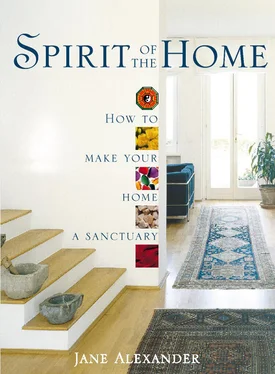REACHING FOR THE SUN
Some psychologists believe that our society has been in the grip of the Helios/Apollo archetype for some considerable time, certainly since the rise of Christianity with its insistence on looking to the life beyond, an afterlife in a heaven situated somewhere ‘up there’ where angels play their harps sitting on clouds and God is enthroned on high. The entire ethos of Christianity has been that life on Earth is relatively unimportant – in order to enjoy life everlasting we need to fix our eyes on God and heaven. So it’s no surprise that Christianity emphasized spirit over body; the heavenly hereafter over our earthly home.
Now science is taking the place of God but we continue to reach upwards. Helios/Apollo is still too dominant. When we become entranced by the sun, lured by the heavens, we forget that we already have a home, here on Earth. Instead we fix our eyes to the stars and think that maybe one day we will leave all this behind. It shows a deep lack of balance in our psyche. In the chakra system you could say that we have become overdeveloped in the upper chakras, shunning the Earth, our roots and our groundedness and reaching only for the pure spiritual ether. We turn towards the sky, heaven, the universe, the masculine, father God and turn our backs on physical matter, the feminine and Mother Earth.
Where does that leave us? In a very uncomfortable place. Without a sense of Earth, we are ungrounded, unbalanced; we have lost our roots. At a very deep level we have lost our home. For the Earth is our home, our only home, like it or not. And in our hearts, in our souls, we recognize the link. We have a deep connection with our planet, and by denying it, by seeking to transcend it, we are cast adrift, as I am in the big city, wandering, always looking for a place to sit and rest for a while.
THE HEARTH — CENTRE OF THE HOME
In order to understand what all this has to do with our physical homes, we need to look back in time, to how the ancients perceived home and the Earth. The very first concept of home was the hearth, the fire that cooked and warmed and kept us safe from wild beasts and cast light into the dread of darkness. This original fire was always round in shape – as if our ancestors knew that the Earth itself was also spherical. In Ancient Greece the structure known as an omphalos was originally a fire banked and covered with earth – a glowing heart, surrounded by the earth. It was considered to be the navel of Gaia, the Earth Mother. Later it became represented as a rounded mound of stones but its symbolism was the same: it demonstrated the link between us and the Earth. Examples can be found, not just in Greece, but all over the world.
So the round hearth became a powerful symbol of home, the centre of every sacred space and, by extension, a symbol of the sacred Earth itself. Since time immemorial the circle has been seen as a symbol of wholeness, of the complete psyche, the fullness of the Self. The Eastern mandala represents the path to the centre, to individuation, to becoming ‘whole’ in soul. Mazes, spirals, labyrinths, circles of standing stones – they all lead from the outside to the inner mystery. The circle is the hidden heart, where the mystics find their gods or goddesses; where others simply find their soul.
The first houses were also round, continuing this close link and honouring our essential connection with Mother Earth. When the great psychologist C.G. Jung built his house at Bollingen he said:
At first I did not plan a proper house but merely a kind of primitive one- storey dwelling. It was to be a round structure with a hearth in the center and bunks along the walls. I more or less had in mind an African hut where the fire, ringed with stone, burns in the middle and the whole life of the family revolves around this center. Primitive huts concretize an idea of wholeness, a familial wholeness …
Jung expanded his basic hut into a two-storey tower – but kept the round shape and the central hearth. He commented that, ‘the feeling of repose and renewal that I had in this tower was intense from the start. It represented for me the maternal hearth.’
ARCHITECTURE — NOT ‘EGOTECTURE’
Just because we are modern people, living fast, furious lives, it does not stop these archetypes resonating within us. In recent years some far-sighted psychologists and philosophers have recognized that we need to rediscover and respect the archetypes within our homes. ‘Every home is a microcosm, the archetypal “world” embodied in a house or plot of land or an apartment,’ says Thomas Moore. ‘A real home is always at once a particular place and the entire world.’ Note he says a ‘real’ home – in other words a home made potent and numinous by the love and feeling we invest in it. ‘Show’-homes just won’t do it. Psychotherapist Robert Sardello drums the point home when he says:
When architecture becomes ‘egotecture’ we live and work in inflated, hollow, monotonous, self-reliant, flashy, defiant space.
I’m sure you know the kind of places he means – buildings which are built and designed so full of pride and prestige that you feel uncomfortable the moment you walk in. You barely like to sit down in case you crease the cushions. These are the kind of homes that make you stand to attention; that make children and animals unwelcome and adults feel ill at ease. They symbolize a complete breakdown between the owner and the Earth – the link is simply not recognized. But anyone with sensitivity of soul can feel it in their bones. The place is not a home, it is a statement – like the latest designer clothes or the smartest sports car. It is hollow.
Sardello continues:
The image of the home invokes archetypal, permanent aspects of Earth connected with the desire to feel at home in the world. The home is more than a box in which to live; it is a soul activity to be retrieved from the numbness of the world of modern objects. Each place of the house, each room, hallway, closet, stair and alcove is a distinct structure that animates different aspects of soul .
THE SYMBOLISM OF THE HOME
A home, then, is a symbol of the world, our own mini-world, our own Mother Earth. When we feel safe and comfortable in our homes then we feel more able to deal with the often frightening outside world. When we start to remember this link consciously and honour our homes in the manner they deserve, which befits such a powerful protective force, we will change our relationship, not only with our homes but also with our wider home, the planet herself. We don’t have to deny our desire for the sky, the heavens and the sun – nobody would want to stay always Earthbound. But a home can be the meeting point between Earth and sky. In classical symbolism, as we’ve seen, the circle was the symbol of the Earth. The square, a four-sided structure, is considered to be the symbol of order, stability and control. So it’s not surprising that we started to build our homes in square and rectangular structures: we were trying to impose order, trying to control the Earth, to make ourselves feel safe. Unfortunately, these shapes with their pointed corners are not as energetically harmonious as the earlier round houses (as we’ll see when we start to look at space clearing and feng shui). But as few of us are likely to be living in rounded houses, we just have to learn how to deal with our corners.
Now notice the next symbolic shape of the house – the slanting roof. All over the world you will see roofs which slant downwards. In practical terms they allow the rain to fall swiftly away from the roof. In symbolic terms, however, the slanting roof is akin to the pyramid shape pointing towards heaven. So the house sits between the Earth and heaven: it offers us a link between the Mother Earth and the Father Sky; between Gaia and God. Again, this was something our ancestors knew all too well. Thomas Moore notes that throughout the world you will find houses decorated with suns and moons, stars and even a dome to reflect the sweep of the cosmos. By adorning the house in such a way, our ancestors would always remember their links: to the Earth via the hearth and to the cosmos via the representations of the stars.
Читать дальше











